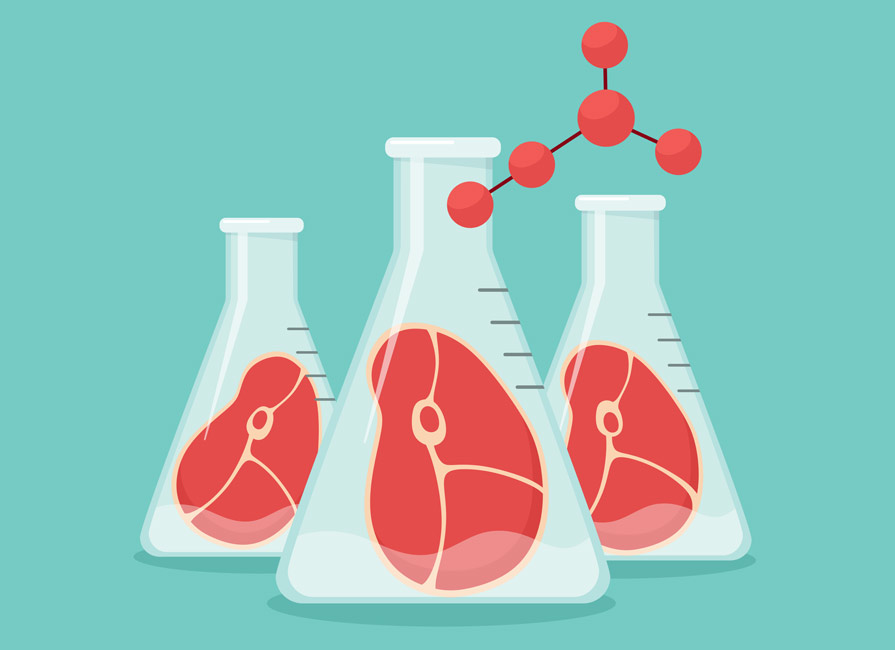One of the key attractions of our Certified Regenerative by AGW program is its practical…

We could soon be eating lab-grown “meat” without even knowing it – unless we take action now.
For those of us who didn’t grow up on a farm, it’s easy to feel overwhelmed by confusing information about the development of synthetic or lab-grown “meat” (also known as cultured “meat” – read on to see why we’ll keep using quotation marks on this term). This is where animal muscle tissue is artificially created in laboratory-like conditions from animal stem cells bathed in nutrients and ‘growth factors.’ Companies have sprung up all over the world in the race to create cultured imitations of beef, chicken—and even shrimp and tuna.
As consumers, most of us just want to be able to buy and enjoy healthful food with our friends and family. Food labeling is supposed to make that easy, simple and safe to do. But the powerful corporations and investors behind the rise of the lab-grown “meat” industry know that many consumers just don’t want to eat the stuff – and that transparent, clear labeling gets in their way.
Despite the hype, there are huge uncertainties about the safe production of lab-grown, as well as the claimed environmental benefits.
NOW IS THE TIME TO SPEAK UP
The United States Department of Agriculture (USDA) Food Safety Inspection Service’s (FSIS) is now taking comments from stakeholders and the public to determine rules around the labeling of lab-grown protein products, referred to as the “Labeling of Meat or Poultry Products Comprised of or Containing Cultured Animal Cells” consultation.
For many of us, even the idea that these items could be considered “meat or poultry products” is disturbing. But unless we all raise our voices, there’s a real risk that lab-grown animal protein products could be sold on supermarket shelves and in restaurants without anyone knowing what they really are.
In seeking public input on this topic, the USDA posed 14 questions, covering topics from whether these products should be differentiated at all, whether they should be called “meat,” and what information consumers would want to know, if any. As you can imagine, we have strong views. You can read our full comments here, but some of our key positions include:
- YES, cell-cultured protein derived from animal cells (aka lab “meat”) should be differentiated from the real thing. Any product which did not originate from a live animal, born from another live animal and raised on a farm, should not be labeled as meat or poultry (or their equivalent) and should be clearly identified as animal cell culture technology.
- Full source material transparency. From both transparency and food safety/allergenic perspective, the product should also clearly specify any and all species of animal cells it derives from, as well as all ingredients and materials used in the manufacturing process.
- Honest, accessible labeling. Information should be clearly communicated in text the same size and visibility as the product name on the actual package—not hidden on a website somewhere. QR codes should not be permitted for use in conveying information about source material, as this limits information access and risks misleading consumers. Do only people with smartphones and extra time at the grocery store deserve to know what’s in their food?
- No animal-raising claims (e.g., “humane,” “Organic,” or breed claims like “Wagyu” and no claims like “natural” or “sustainable.” Because no animals were raised, bred, handled, fed, or cared for in any way, there can be no truthful statement made about their production. Consumers increasingly seek products which have been verified to deliver positive benefits to the environment, animals and rural communities (like those from AGW-certified farms and ranches). No such benefits have been demonstrated for cell-cultured protein derived from animal cells.
- Don’t call it steak! To ensure fair and transparent markets for farmers and clarity for consumers, this new technology should be differentiated from traditional meat and poultry products. “Cell-cultured protein” should be the generic product name, with the product specifying which animal cells it derives from. For example, “Made with cell-cultured protein derived from bovine cells.”
USE YOUR VOICE – TAKE ACTION NOW
You’re being invited to comment, too. As someone who eats food, you have a stake in this process. If you agree with us and think lab-grown “meat” should be clearly labeled to avoid consumer confusion – and ensure we can all choose the kind of food and food production systems we want – please take a look at our response here, and use it to submit your own comments here by December 2nd.
Thank you for using your voice for a more transparent food system!


